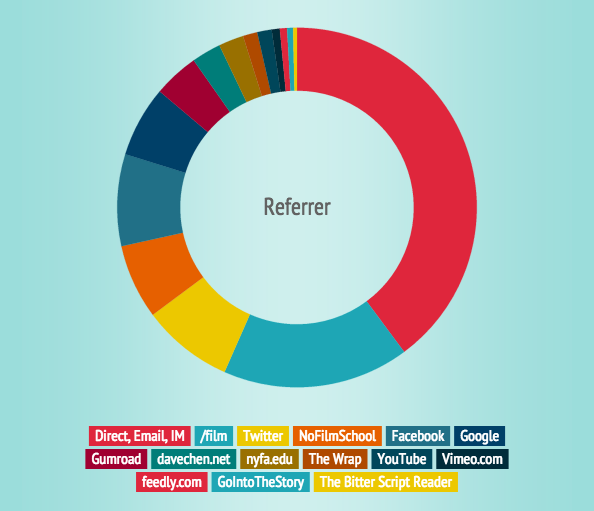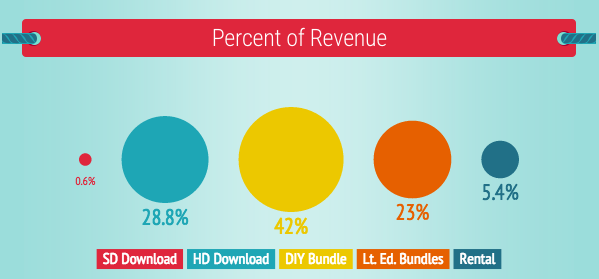How Much Money 'Layover' Made: The Financial Afterlife Of A Micro-Budget Indie Film
Last summer I signed on to produce a movie called Layover, an indie film I saw at the Seattle International Film Festival. I had a number of reasons for wanting to work on the film, but one of them was to learn the ins-and-outs of self-distribution, which is something that I felt was (and still is) a possible outcome for my own film, The Primary Instinct.
When Layover was self-released, we received placement in many high-profile online outlets (as well as a nice mention on the /Filmcast). The filmmakers, actors, and myself promoted the film heavily across social media. Combine all this with an asking price of $6 for a full HD digital download, and we had every reason to expect that the film would have a profitable run, especially given that the film's budget was only $6,000. Were we right? How much money do you think our film made?
Now that some time has passed, we've had the opportunity to take stock and re-evaluate the effectiveness of our release strategy. After the jump, I will detail the plan we executed and tell you exactly how much revenue the film has earned.
First things first: Layover is not a very commercial film. There are no stars in it that are recognizable to mass audiences. It doesn't fit into any conventional genre. And the vast majority of the film is subtitled in French. So, we had our work cut out for us.
While Layover did receive a few offers for distribution, none of them were particularly appealing to the filmmakers, director Joshua Caldwell and producer Travis Oberlander. Oberlander recalls, "When we reviewed the contracts, we realized that most distribution guaranteed very little upside, beyond being able to claim that we had gotten a deal for Layover. Ultimately, we decided to release Layover directly to our audience utilizing the many tools now available for filmmakers and our own online marketing know-how."
After evaluating many platforms the filmmakers decided to use Gumroad and Vimeo On Demand to release their film. Both companies are trying to beef up their On Demand offerings and both are incredibly generous about the revenue split (typically 90/10, in the content creators' favor). Both are also really easy to use and offer lots of customization options for directors. Perhaps their biggest downside is that they have nowhere near the market penetration (or association as "a place to buy high-quality movies") as Amazon or iTunes.
The filmmakers targeted an October release date. To gin up publicity, they pitched stories and got placements at sites like NoFilmSchool, The Wrap, and FilmSchoolRejects (as well as /Film). The stories focused on the unique angle of Caldwell making the film for such a cheap price, using only a single Canon 5D Mark II (learn more about that by watching my interview with him). Moreover, Layover's trailer was featured on a popular YouTube channel and the film landed a nice Featured placement on Vimeo's On Demand page. Here's a chart detailing which referrer pages drove the most traffic to layoverfilm.com. Direct messages (IMs, emails, etc.) accounted for the plurality of referrals, while /Film, Twitter, Facebook, and NoFilmSchool followed closely behind.

That being said, not all traffic is created equal. While blogs/sites drew a lot of traffic, the biggest revenue generator by far came from direct referrals, i.e. people who had directly IMed/emailed someone they knew to recommend the movie. Thus, press is important, but getting people to talk about your film is even more important.
The filmmakers decided to use Layover's release as an opportunity experiment with premium bundles. "As soon as we decided to self-distribute Layover, we knew we wanted to provide extra content for a premium cost. We had read about the success of bundle pioneers like Indie Game: The Movie and Camp Takota and had read countless articles promoting the technique," Oberlander explained. Thus, the price to watch the movie ranged from $3 for a rental to $100 for a limited edition HD bundle, which included things like special features, resources for filmmakers and a consulting session with Caldwell himself. Those limited edition bundles sold out within the first two weeks and only accounted for 3% of unit sales but drove nearly 25% of revenue. We cannot overstate how important bundles were as a part of overall revenue.

So, after all that work, what was the total revenue for the film? $4,147.24
The film, despite having a minuscule budget, is not yet profitable. There are many potential explanations for this. The nature of the film (as I've mentioned above) and the lack of ability to get more press could have contributed. But for me, this whole experience was a testament to how difficult it is to get people to watch a film that has no obvious genre hook, no widely recognizable stars, and virtually no marketing budget (AKA the situation most indie films find themselves in). When you release a film today, you're competing not just with other films. You're competing with all their screentime, whether it's on TV, YouTube, Facebook, Twitter, etc. In order to motivate people to watch, you need to give them something that will inherently grab their attention – or at least be able to use marketing dollars to be a bit more proactive about getting the word out. While this film definitely did that for some people, that group was not large enough to bring us into profitability.
That being said, the film will exist for a long time and will serve as a neat calling card for the filmmakers as they move on to their next projects. The crash course in self-distribution was also invaluable, as we now have a better sense of the advantages and disadvantages of using a distributor.
It's typically crass to talk about money but one of the purposes of disclosing this information is we hope it will help indie filmmakers who are trying to figure out how to distribute their films. Every movie is different, and the things that worked for us might not work for your film (or vice versa). But we now live in an age where filmmakers who operate outside of the studio system need to be conscious of how they market themselves and their product. We hope that this information will provide some decent data points as people figure out their own films' path.
By the way: If you want to support self-released indie movies like ours, you can still purchase Layover at Layoverfilm.com. Use promo code "filmcast" to get a discount and purchase the film for $6. Also: you can see the full infographic that some of the images above were derived from here.
